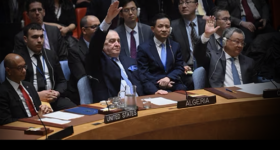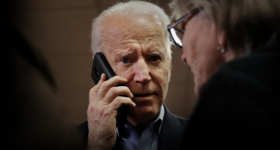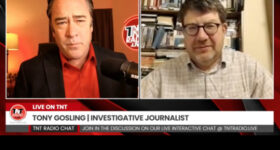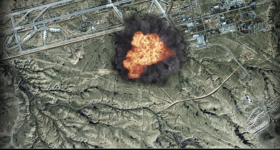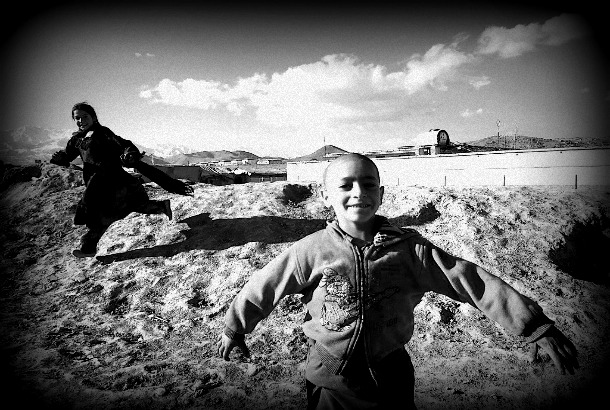
Andre Vltchek
ICH
It is now winter in Kabul, end of February 2017. At night the temperature gets near zero. The mountains surrounding the city are covered by snow. It feels much chillier than it really is. Soon it will be 16 years since the US/UK invasion of the country, and 16 years since the Bonn Conference, during which Hamid Karzai was “selected” to head the Afghan Interim Administration.
Almost everyone I spoke to in Afghanistan agrees that things are rapidly moving from bad to rock bottom.
Afghans, at home and abroad, are deeply pessimistic. With hefty allowances and privileges, at least some foreigners based in Kabul are much more upbeat, but ‘positive thinking’ is what they are paid to demonstrate.
Historically one of the greatest cultures on Earth, Afghanistan is now nearing breaking point, with the lowest Human Development Index (2015, HDI, compiled by the UNDP) of all Asian nations, and the 18th lowest in the entire world (all 17 countries below it are located in Sub-Saharan Africa). Afghanistan has also the lowest life expectancy in Asia (WHO, 2015).
While officially, the literacy rate stands at around 60%, I was told by two prominent educationalists in Kabul that in reality it is well below 50%, while it is stubbornly stuck under 20% for women and girls.
Statistics are awful, but what is behind the numbers? What has been done to this ancient and distinct civilization, once standing proudly at the crossroad of major trade routes, influencing culturally a great chunk of Asia, connecting East and West, North and South?
How deep, how permanent is the damage?
During my visit, I was offered but I refused to travel in an armored, bulletproof vehicle. My ageing “horse” became a beat-up Corolla, my driver and translator a brave, decent family man in possession of a wonderful sense of humor. Although we became good friends, I never asked him to what ethnic group he belonged. He never told me. I simply didn’t want to know, and he didn’t find it important to address the topic. Everyone knows that Afghanistan is deeply divided ‘along its ethnic lines. As an internationalist, I refuse to pay attention to anything related to ‘blood’, finding all such divisions, anywhere in the world, unnatural and thoroughly unfortunate. Call it my little stubbornness; both my driver and me were stubbornly refusing to acknowledge ethnic divisions in Afghanistan, at least inside the car, while driving through this marvelous but scarred, stunning but endlessly sad land.
KABUL
One day you and your driver, who is by then your dear friend, are driving slowly over the bridge. Your car stops. You get out in the middle of the bridge, and begin photographing the clogged river below, with garbage floating and covering its banks. Children are begging, and you soon notice that they are operating in a compact pack, almost resembling some small military unit. In Kabul, as in so many places on earth, there is a rigid structure to begging.
After a while, you continue driving on, towards the Softa Bridge, which is located in District 6.
Where you are appears to be all messed up, endlessly fucked up.
You were told to come to this neighborhood, to witness a warzone inside the city, to see ‘what the West has done to the country’. There are no bullets flying here, and no loud explosions. In fact, you hear almost nothing. You actually don’t see any war near the Softa Bridge; you only see Death, her horrid gangrenous face, her scythe cutting all that is still standing around her, cutting and cutting, working in extremely slow motion.
Again, as so many times before, you are scared. You were scared like this several times before: in Haiti, in the Democratic Republic of Congo, Kashmir, Sri Lanka, Timor Leste, Iraq, and Peru, to name just a few countries. In those places, as well as here in Kabul, you are not frightened because you could easily lose your life any moment, or because your safety might be in danger. What dismays you, what you really cannot stomach, are the images of despair, those of ‘no way out’, of absolute hopelessness. Lack of hope is killing you, it horrifies you; everything else can always be dealt with.
People you see all around can hardly stand on their feet. Many cannot stand at all. Most of them are stoned, laying around in rags, sitting in embryonic positions, or moving aimlessly back and forth, staring emptily into the distance. Some are urinating publicly. Syringes are everywhere.
There are holes, deep and wide, filled with motionless human bodies.
First you drive around, photographing through the cracked glass, then you roll down the window, and at the end, you get out and begin working, totally exposed. You have no idea what may happen in the next few seconds. Someone begins shouting at you, others are throwing stones, but they are too weak and the stones just hit your shoulder and legs, softly, without causing any harm.
Then a bomb goes off, not far from where you are. There is an explosion in the 6th District, right in front of a police station. You cannot see it, but you can clearly hear the blast. It is a muffled yet powerful bang. You look at your phone.
It is March 1st, 2017, Kabul. Later you learn that several people died just a few hundred meters from where you were working, while several others perished in the 12th District, another few kilometers away.
The smoke begins rising towards the sky. Sirens are howling and several ambulances are rushing towards the site. Then countless military Humvees begin shooting one after another in the same direction, followed by heavier and much clumsier armored vehicles. You are taking all this in, slowly; photographing the scene, and then snapping from some distance a monumental but still semi-destroyed Darul Aman Palace.
And so it goes.
Tall concrete walls are scarring, fragmenting the city. In Kabul, almost anything worth protecting is now fenced. Some partitions and barriers are simply enormous, almost unreal. There are walls sheltering all foreign embassies and government buildings, palaces, military bases, police stations and banks, as well as the United Nations compounds, even most of the private schools and hotels. The Hamid Karzai international airport is encompassed by perimeters that could put to shame most of the Cold War lines: from the parking area one has to walk almost one kilometer to the entrance of the international terminal, with luggage and through the countless security checks.
Of course Western institutions and organizations have the most impressive fences, as well as the Afghan military and military bases and government offices.
Enormous surveillance drone-zeppelins are levitating above the city.
It could all be seen as thoroughly grotesque, even laughable, but no one is amused. It is all very serious, damn serious here.
Afghanistan has been gradually overtaken by something absolutely foreign: by the Western-style security apparatus. Tens of thousands of highly paid North American and European ‘experts’ have been getting extremely busy, fulfilling their secret wet dream: fencing everything in sight, monitoring each and every movement in the capital city, building taller and taller barriers, while installing the latest hi-tech cameras at almost every intersection, and above each gate.
Not far from the Embassy of the United States of America (or more precisely, not far from the Great Chinese Wall-size fence encompassing it), I noticed a familiar complex of buildings, reminding me of those that used to be constructed in all corners of Eastern Europe and Cuba. I asked my friend to drive into one of the compounds.
This is how I entered “Makroyan”. We killed the engine, and everything around us was suddenly quiet, almost dormant. Time stopped here. There was a certain mild decay detectable all around the area, but upon a closer look, those old apartment buildings were still looking decent and strong, with very impressive public spaces in between them. Here I felt that I was allowed a rare glimpse of an old, socialist Afghanistan.
I stopped in between two entrances of Block 21: No.2 and No.3. I looked up to the 4th floor. Who is living there now? Who used to live here before, some 25, even 30 years ago?
A destroyed office chair was standing aimlessly in the middle of a parking lot, and an old, disabled man was crawling desolately on all fours, moving away from the block. There was a Soviet-built school right next to Block 21. It used to be known as Dosti primary school, and I was told that during the war, it was bombed a couple of times and lots of kids died inside it. Now the school is private and it has a new name – it is ‘Alfath’, a high school.
Apart from a few loose, rusty wires and fences, everything looks decent and semi-neat. This is where many members of the diminishing Kabul middle class still prefer to live. Blocks of Makroyan are reassuring; they radiate safety and permanency, while being surrounded by a volatile and frightening universe.
All of a sudden, I imagined a boy and a girl, who perhaps used to live here, so many years ago. As children in all other parts of the world do at that age, they were just slowly beginning to discover life, starting to formulate their dreams and expectations. In those days, the new leafy neighborhood would have been like a promise of a brighter future, of a much better country.
Then suddenly, full stop.
A war. A sudden end to all that the future was promising. Collapse of optimism, or enthusiasm, of confidence. Only death and destruction, and shattered dreams, remained. For those who were at least somehow lucky: a bitterness and then a hasty flight, instead of ultimate misery and death. Full stop. Total reset. Everything collapsed. But life never stops, it goes on, it always does. Things re-composed, somehow, not idyllically, but they did.
For a long time, I kept staring at Block 21. Memories kept coming, as if I used to live there myself, many years ago, when I was a child. I hardly noticed that it was getting very cold. I began to shiver. I didn’t want to leave, but I had to. Fresh pomegranate juice at a local street stall brought me back to reality, it woke me, but it didn’t managed to warm me up.
GREAT HISTORY, CHANGING CULTURE, AN ON-GOING OCCUPATION AND FEAR
A renowned Afghan intellectual, Dr. Omara Khan Masoudi, who used to be, among many other things, the former head of the National Museum, is now bitter about the changes invading the culture of his country:
“In the past, we had also many ethnic groups living in this country, but they used to coexist in harmony. Then, our culture got influenced by conflicts and violence.
Before the war, it was the culture that used to represent us in the world. However, during and after the war, our cultures were used to justify the conflict.”
Dr. Masoudi told me that he thinks it is wrong when culture falls into the hands of divisive politicians. “If culture is politicized, it loses its essence”, he declared.
I asked him whether he thinks it also applies to Latin America, to the former Soviet Union and China, where (at least to a great extent) ‘politicized culture’ has been playing an extremely important role, determining the course of development. He smiled, replying:
“To be precise, politicizing cultures is not always such a bad thing… When it’s done, for instance, in order to achieve social progress or equality, I have nothing against it. But I am outraged when people like some religious leaders; Shia, Sunni or even some extremists, do it… Culture is very broad, and religions are only a part of it. But in Afghanistan, religious leaders have been using the culture for their narrow-minded interests.”
In a coffee shop, which is lost somewhere inside the wilderness of an international and United Nations compound called ‘The Green Village’, my Japanese friend and Head of the Culture Unit of UNESCO, Mr. Masanori Nagaoka, explained:
“Afghanistan or Ancient Ariana, as many ancient Greek and Roman authors referred to the region in antiquity, can be acknowledged as the multi-cultural cradle of Central Asia, linking East and West via historically significant trade conduits that also conveyed ideas, concepts and languages as a cultural by-product of fledgling international commerce. As a result, contemporary Afghanistan is a multi-ethnic, multi-lingual society with a complex history stretching back many millennia. The numerous civilizations are attested to in the archaeological record, both indigenous and foreign….”
However, he is well aware of the complexities faced by the country and the culture torn apart by lethal conflicts of the last decades and centuries.
“Afghanistan is unfortunately also a nation fragmented by a history of protracted conflict, exacerbated by geographic isolation for many communities and limited or unequal access to infrastructure and resources, both regionally and demographically. As a nominal starting point, the ongoing rehabilitation process in Afghanistan needs to address these issues if the nation is to unify under a common objective, fostering a veracious society free from conflict and where ethnic diversity is recognized for its social, cultural and economic benefits rather than, as is often the case, seen as a hindrance to particular developmental objectives. Part of the solution to this problem lies in the campaign of a positive public discussion to promote inter-cultural understanding and to raise awareness of the potential that such discourse has to contribute to the broader goals of rapprochement, peace-building and economic development in Afghanistan.”
I flew to the city of Herat, where I witnessed tremendous masterpieces of architecture, from the marvelous and recently restored Citadel (as valuable as the citadels of Aleppo and Erbil), to the Friday Mosque and amazing, unique minarets rising proudly towards the sky.
How familiar all those architectural treasures appeared! On several occasions I approached Nasir, my local friend who was always eager to share the impressive history of his region:
“Look, this could be in Delhi… and this in Samarkand!”
Sure enough, the most visited world heritage site in India, Qutub Minar, situated right outside New Delhi, is perhaps the greatest symbol of the Indo-Islamic Afghan architecture, while both Herat and Samarkand were connected by the Silk Road and historically kept influencing each other.
In Afghanistan, the history, the occupation and the on-going conflict: everything seems to be thoroughly intertwined.

Italian troops took over ancient Citadel in Herat City
During my work there, the Citadel of Herat was literally taken over by Italian troops. I was told that some high-ranking NATO officer was visiting the site, and with no shame, a fully armed Italian commando was roaming around, “securing” every corner of the vast courtyard. As if Afghans had lost control of their own country!
On closer examination, the madrassa of Hussein Baiqara is, in reality, still a minefield. In between four stunning minarets, a de-mining team from local “Halo Trust” was manually searching for unexploded ordinances. I was allowed to enter, but only as a war correspondent and at my own risk, definitely not as a ‘tourist’.
“On this site, we already found two mines and 10 unexploded ordinances”, I was told by one of the Halo Trust experts. “Now this entire area is off-limits to the public. Not long ago, one child was badly injured here; he lost his leg.”
Nothing is peaceful in Afghanistan, not even ancient historic sites.
Not much is questioned here.
Positive talk about the ancient history and culture is generally encouraged, but to discuss dramatic changes in modern Afghan culture, those that occurred as a result of the US/UK invasion and the present on-going NATO occupation of the country, is almost entirely off-limits. In fact, even the word itself – ‘occupation’ – could hardly be heard. Instead, such jargons as ‘protection’, ‘defense’ and ‘international help’ have been implanted deeply and systematically into the psyche of most Afghan people.
The culture that was known for long centuries for its passion for freedom and independence seems broken. While Afghans resisted heroically against all past British invasions, while some of them fought the Soviet incursion, there is presently no organized and united (national, not religious) opposition against the Western occupation of the country.
I met academic Jawid Amin, from the Academy of Social Sciences of Afghanistan, in a small guardroom in front of the Museum of Modern Arts in Kabul.
I asked him, whether there is any art, or any group of intellectuals openly critical of the United States, and of the occupation. He replied, sincerely:
“We don’t have anyone openly critical of the US or the West here, because it is simply not allowed by the government. I personally don’t like the Americans, but I can’t say more… Even I work for the government. My brother and sister are living in the United States. And about critical arts: nothing could be exhibited here without permission from the government and since Karzai, the government is controlled by the West…”
A prominent Afghan intellectual, Omaid Sharifi, explained over the phone: “In the provinces, you can still see paintings depicting killing of civilians by the US drones… but not in Kabul.”
I’m trying to work as fast as possible, meeting people who are helping to shed light on the situation. Eventually, a dire picture begins to form.
I met a Japanese reporter who has been living in Afghanistan for almost a quarter of a century. Her assessment of the situation was to a large extent pessimistic:
“Afghans had very little choice… It is 100% true that behind Karzai’s government was the US… Afghans didn’t want to accept foreign intervention, but soon they learned how money plays an important role. The entire Afghan culture is now changing, even some essential elements of it like hospitality: people don’t want to spend money on it, or they don’t have any that they can spare…”
I asked Dr. Masoudi why Afghan culture did not accept Soviets and their egalitarian, socially oriented ideals, while it seems to be tolerating the Western invasion, which is spreading inequality, desperation and subservience. He replied, passionately:
“The biggest mistake the Soviet Union made here was to attack religion out rightly. If they’d first stick to equal rights, and slowly work it up towards the contradictions of religion, it could perhaps work… But they began blaming religion for our backwardness, in fact for everything. Or at least this is how it was interpreted by the coalition of their enemies, and of course by the West.
Now, why is the Western invasion ‘successful’? Look at the Karzai regime… During his rule, the US convinced people that Western intervention was ‘positive’, ‘respectful of their religion and cultures’. They kept repeating ‘under this and that UN convention’, and again ‘as decided by the UN’… They used NATO, a huge group of countries, as an umbrella. There was a ‘brilliantly effective’ protocol that they developed… According to them, they never did anything unilaterally, always by ‘international consensus’ and in order to ‘help Afghan people’. On the other hand, the Soviet Union had never slightest chance to explain itself. It was attacked immediately, and on all fronts.”
“Opposition to Western occupation? Anti-Western art?” A Russian cultural expert in Kabul was clearly surprised by my question.
“First of all, the Taliban destroyed most artistic traditions of this country. But also, the economic and social situation in this country is so desperate, that hardly anyone has time to think about some larger picture. More than 60% of Afghans are jobless. One thing you also should remember: Afghan people are very proud and very freedom loving, as the history illustrated, but they are also extremely patient. Go and see The British Cemetery. It was built in 1879 to hold the dead of the second Anglo-Afghan War, but despite all that the UK did to this country, and despite all recent wars and conflicts, it was never attacked, never damaged.”
It is true. I never heard anyone discussing this topic. All horrid British crimes committed on the territory of Afghanistan seem to be forgotten, at least for now.
But that’s not all: nobody here seems to have any appetite for recalling those horrors of the last decades, triggered by Western imperialism. Not once I observed any discussion addressing the main topic of modern Afghan history: how the West managed to trick the Soviets into invading Afghanistan in 1979, and how it created and then armed the vilest bunch of religious fanatics – the Mujahedeen. And how, subsequently, both countries – Afghanistan and the Soviet Union – were thoroughly destroyed in the process.
All was done, of course, with “great respect” for the Afghan nation, for its culture and traditions, as well as (how else) religion.
I’d love to be an invisible witness in a modern history class at the American University of Afghanistan, a ‘famed’ institution that is literally regurgitating thousands of collaborators, manufacturing a new breed of obedient pro-Western ‘elites’.
As we drive past Jamhuriat Hospital (Republic Hospital), which had a new 10- story building, with capacity for 350 patients, constructed by China in 2004, my driver, Mr. Tahir, sighs:
“This was really a great gift from China to us… the Chinese really work hard, don’t they?”
“They have plenty of zeal and enthusiasm”, I uttered carefully. “Socialist fervor, you know. They sincerely believe in building, improving their country and the world. It is quite contrary to Western nihilism and extreme individualism…”
“They must love their country…”
“They do.”
“Afghanistan is poor”, Mr. Tahir’s face became suddenly sad. “Our people don’t love their country, anymore. They don’t work to improve it. They only work for themselves now, for their families…”
“Was it different before? You know…” I made an abstract gesture with my hand. “Before all this…”
“Of course it used to be very different”, he replied, grinning again.
NOTHING SOCIAL LEFT, NOTHING SOCIALIST WANTED
I stopped several people who were just walking down the street, in various parts of Kabul. I wanted to understand some basics: was there anything social left in Afghanistan? Did Western ‘liberation’ bring at least some progress, social development and improved standards of living?
Most answers were thoroughly gloomy. Only those people who were working or moonlighting for the Western military, for the embassies, the NGOs or other ‘international contractors’, were to some extent optimistic.
I was explained that almost everyone in the countryside and provincial cities were out off work. Unemployment among university graduates stood at over 80%.
In Herat, a city of almost half a million inhabitants, a long and depressing line was winding in front of the Iranian embassy. I was told that tens of thousands have already migrated to the other side of the border. Now Afghans who were attempting to visit their relatives living in Iran were told to leave a 300-euro deposit, in case they decide not to return.
I asked what Herat is producing, and was told, without any irony: “mainly just some washing powder and biscuits”. Tourism from Iran stood at only about 150 people a year! The area between the city and the border has been dangerous, and there are frequent kidnappings.
In most provincial cities, a regular family has to get by on 2.300 – 2.500 Afghanis per month, which is not much more than US$30.
Government supplies run water mainly to the government housing projects. People living elsewhere have to dig their own wells.
Electricity is expensive, and an average family in Kabul is now expected to pay around US$35 per month. Even in the capital, many people have to get by without electricity. Indian ‘investors’ are in partnership with the government. Electricity supplies, and even water, are perceived as ‘business ventures’, not as basic social services.
Counting on a decent public transportation in the past, Kabul is now forced to rely on private vehicles, and on those few ‘city buses’ that are ‘pro-profit’ and mainly privately owned and operated.
There are government schools in Afghanistan, and in theory they are free, but books, pencils, uniforms and other basics are not.
In fact, perhaps the most impressive modern structure in Kabul, is actually the 10-story building to Jamhuriat Hospital, a gift from the People’s Republic of China, not from the West.
One wonders where is that fabled great ‘assistance’ from the United States and Europe really going? Perhaps to the millions of tons of concrete, used for construction of the massive fences? Perhaps money sponsors’ purchases of high-tech cameras and surveillance systems, as well as the high-life of thousands of Western ‘contractors’ and ‘security experts’?
I spoke to more than hundreds of Afghan people. Almost no one was ready to mention socialism. As if this wonderful word disappeared, was erased from the local lexicon.
“They actually remember socialism very fondly”, my Japanese acquaintance based in Kabul once told me. “However, talking about it is not encouraged. It may cause all sorts of problems.”
WESTERN (TEMPORARY) VICTORY
While in Kabul, I was told by one of the local experts working for an international organization:
“The National Education Strategic Plan (NESP) for Afghanistan was just drafted… The funding came from the West. Many meetings were held directly at the US embassy and at the offices of the World Bank. The Afghan Ministry of Education had very little say about the curriculum, which was basically dictated by the Western countries…”
I cannot quote the source of this information, as she would most probably lose her position for expressing such views.
She later clarified further:
“The policy decisions on education are proposed by donor parties, which are mostly Western countries. The Ministry of Education, with limited capacity, has a lesser role in drafting the NESP III policy. Instead of building the capacity of the government, donor countries are taking the leading role in changing the education system and this does not ensure a sustainable education for Afghanistan whatsoever.”
As in all client states of the West, education in Afghanistan is manipulated and geared to serve the interests of the West. It is expected to produce obedient and unquestioning masses. Instead of determined and productive patriots, it is regurgitating butlers of the regime, which is in turn serving predominately foreign interests.
Almost all information flows through the channels that are at least to some extent influenced from abroad: social media, television networks as well as the printed media.
The fabled Afghan spirit of resistance and courage has been (hopefully only temporarily) brutally broken, under the supervision of highly professional foreign indoctrinators and propagandists.
Those who are willing to collaborate with the occupation forces are suddenly not even hiding it, carrying their condition proudly as if a coat of arms, not as a shame. Many are now delighted to be associated with the West and its institutions.
In fact, the occupation is not even called occupation, anymore, at least not by the elites who are well rewarded by the system for their linguistic and intellectual somersaults and pirouettes.
And Afghan people keep leaving.
Afghanistan is shedding its most talented sons and daughters, every day, every month, irreversibly.
Ms. Yukiko Matsuyoshi, a former Japanese diplomat, presently a UN education expert, is worried about the current trends in Afghanistan, a country where she spent several years:
“Now the social classes have been re-created after the fall of Taliban, but the country seems to have no ideology. People just follow trends that are thrown their way. There is corruption, there is that huge poppy business, and there are palaces. And there is misery in the countryside, hardly any access to information. Afghans are leaving their country. Whoever can, goes: good people, government people…it seems like everyone tries to escape.”
All of a sudden, the West is perceived like some Promised Land. Those who make it there are bragging about their new ‘home’, sending colorful images through social media: Disneyland, Hollywood, German castles…
I have seen the other side of the coin, in terrible refugee camps in Greece, in the French Calais camps; people drowning while attempting to cross the sea from Turkey to the European Union.
There is no discussion whether Afghanistan should be capitalist or socialist, anymore. Debate has stopped. The decision has been made, somewhere else, obviously.
The faces of Northern Alliance leaders are ‘decorating’ (or some would say, ‘scarring’) all major roads on which I drove. Ahmad Shah Massoud became a national hero, during the Karzai regime.
I travelled more than 100 kilometers north, to see Massoud’s grave, or a thumb, or whatever that monstrosity they erected above the splendid Panjshir Valley really is. Hordes of people drive there on weekends, some all the way from Kabul, and there are even those who pray to the ‘leader’.
The former “anti-Soviet” and anti-Communist fighter, he is certainly a perfect ‘hero’, whose memory is groomed by the pro-Western regime.
Driving through the Panjshir Valley, I saw several Soviet tanks and armored vehicles, rotting by the side of the road. I also saw a destroyed village, an eerie reminder of the war. It is called Dashtak. Clay houses look like a cemetery, like a horrid monument.
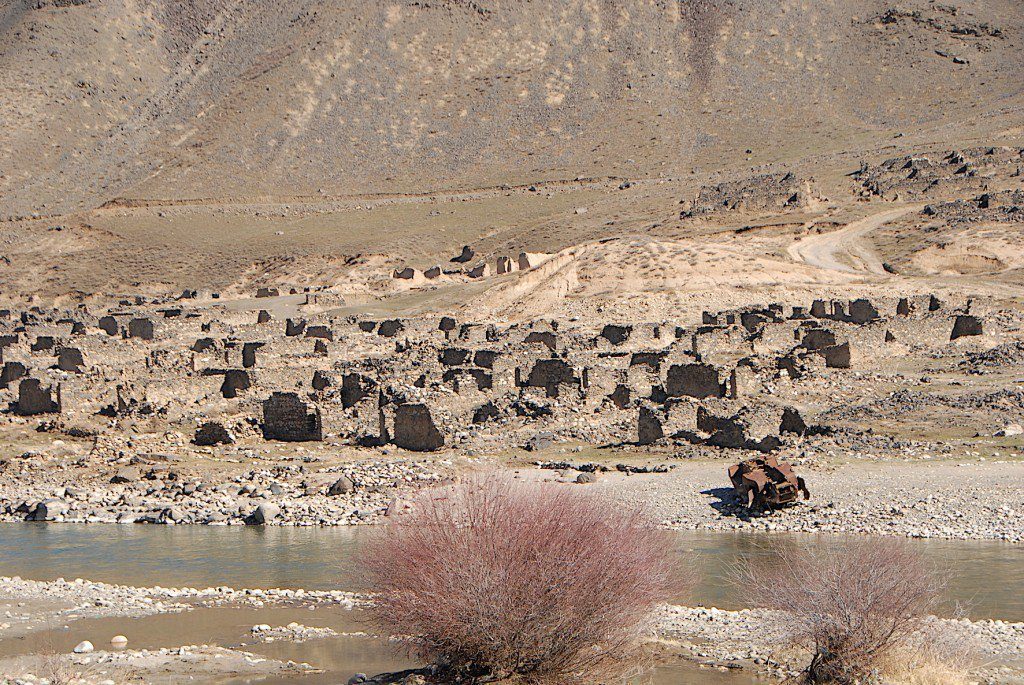
Village in the North destroyed during the war
I took photos and sent them to Kabul, to my friends, for identification. I want to know, I felt that I had to know, who razed this town by the river, surrounded by such stunning mountains.
The answer came in a just few minutes: “I think it was in 1984, by the Soviet Union”. What followed was a link leading to a book published in the West, quoting some former Ukrainian, Soviet adviser to an Afghan battalion commander. The name of the book was “The Bear Went Over the Mountain”.
The quote did not sound too convincing. “Let’s go back”, I asked my driver and translator. “Let’s talk to people on the other side of the river’.
We found three inhabitants, in three different parts of the village; three people old enough to remember what took place here, some 30 years ago. All three testimonies coincided: Massoud’s forces brought refugees from several other parts of the valley. Before the battle began, all of them left. During the combat, clay houses were destroyed, but no civilians died inside.
There are always many different interpretations of the historic events. However, the analyses of modern Afghan history disseminated by the West and the Afghan regime among the Afghan people, are suspiciously unanimous and frighteningly one-sided. I am definitely planning to revisit this point during my next trip to the country. I see it as essential. The future of Afghanistan certainly depends on understanding the past.
There are huge zeppelin-drones, vile-looking airborne surveillance stuff, hovering over the US air force base near Bagram. The same drones could be seen levitating over Kabul, but in the Bagram area, with the dramatic backdrop of the mountains, they look particularly dreadful.
The air force base is huge. It appears even bigger than Incerlik near Adana in Turkey. It is an absolute masterpiece of military vulgarity, with watch towers everywhere, with barbed wire, several layers of concrete walls, surveillance cameras and powerful lights. If this is not an occupation, then what really is?
Again, my driver is totally cool. I want to photograph this monstrosity, and he drives me around, so we can identify a truly good spot. I’m ‘calculating light’, looking for the correct angle, so during the sunset, those who would be observing us from inside the ‘castle’, would be blinded, and we could get at least a few decent images.
I’m aware of the fact that in Afghanistan, the Empire often kills anything that moves, at the slightest suspicion or without any suspicion at all, as for them human lives of the local people count for almost nothing.
Once the sun goes down, I begin working fast.
Somehow I feel that my visit to Afghanistan would be incomplete, without getting at least some images of the base – one of the most expressive symbols of the occupation.
So this is what Afghanistan became under the Western ‘liberating’ boots! Barbed wires, foreign jet fighters, concrete walls everywhere, battles with the religious fundamentalist elements (invented and manufactured by the West), grotesque savage capitalism, ignorant or shameless collaboration, and guns, guns and guns, as well as misery in almost every corner, and one of the lowest life expectancies and standards of living on Earth! And of course, people escaping, leaving this beautiful country behind – a country, which is suddenly unloved, humiliated, abandoned by so many!
This is all happening only roughly four decades after the heroic attempts to build some great social housing projects, after the implementation of a well-functioning public transportation network, public education and medical care, as well as an attempt to introduce secularism, while building a decent, egalitarian society.
The glorious victory of Western imperialism over one of the oldest and greatest cultures seems to be complete. The Brits tried, on several occasions; they murdered and tortured, but were defeated. They never forgave. They waited for decades, and then returned with their muscular and aggressive offspring. And here they are, all of them, now!
Afghanistan appears to be exhausted and defeated. It is badly injured, and it has been dragged through unimaginable dirt.
But I don’t think it is crushed, by the West or by the religious fundamentalists, or by these two historical allies.
Deep inside, Afghanistan knows better. It already experienced many years of hope; it knows the taste of it. During long centuries and millennia of its existence, it survived several dreadful moments, but it always stood up again, undefeated and proud. I’m certain that it will rise again.
Flying, driving or walking through its magnificent mountains, I often felt that Afghanistan is like a living organism, it was winking at me, letting me know that it is alive, that it sees everything that goes on, that it is not futile at all to struggle for its future.
I watched the stubs of the electric contacts that used to hold, some decades ago, those long wires used by the legendary Kabul trolley bus network.
“Those beautiful vehicles came from former Czechoslovakia”, a man, an office worker, whom I stopped in the center of the city, told me. “They were beautiful, and do you know who used to drive them? Some young girls; optimistic women who were for some reason always in a good mood.”
Apparently Kabul had three trolleybus lines, one of them originating (or ending) at the ‘Cinema Pamir’. What color were Kabul trolleybuses? I saw some photos, but those I could find were black and white. When I was a child, growing up in Czechoslovakia, ours were red. The ones in Leningrad, the city where I was born, were blue and green, some red as well. When they were accelerating, it was as if they’d be singing a simple song, or whining, complaining mockingly about their hard life.
I imagined a strong-minded, professional woman, boarding these trolleybuses. Perhaps eager to catch one of those old great Soviet movies at the Cinema Pamir, perhaps “the Dawns are Quiet Here”, or going to work or to visit different parts of the city. She would snuggle into a comfortable seat in the electric vehicle. It was getting dark, but the city was safe. A woman behind the wheel was really smiling. There were flags flying all around the city. There was hope. There was a future. There was a country to build and to love.
I had suspected that the Kabul trolleybuses were actually light blue. I have no idea why. It was just my intuition.
Suddenly I heard a loud bang, and then the squeaking of brakes.
“Roll up the window!” my driver was shouting. We were getting into a slum inhabited by IDPs. We left the road. Dust everywhere, absolute misery. Bagrani town, now Bagrani slums, just a few kilometers east from Kabul, on the Jalalabad Highway.
I grasped the heavy metal body of my professional Nikon.
My dream about Afghanistan of the 70’s, a gentle and enthusiastic country, abruptly ended. Now all around me were children suffering from malnutrition. I heard excited, accusatory voices of men and women who were forced to come from all corners of Afghanistan. We drove on a bumpy road, towards numerous half-collapsed clay structures and dirty tents.
“We escaped fighting in Shinwar, Helmand Province, from around Jalalabad and Kandahar”, several internally displaced persons living in Bagrani were shouting at me:
“We have 1.000 families from Helmand and more than 1.000 families from Kandahar, living here. We lost our houses back in our villages and towns… People around Jalalabad lost their homes, too. Daesh (ISIS) is operating in several parts of the country… Taliban fighters are frequently changing sides, joining Daesh. There is fighting going on everywhere: Daesh, Taliban and the government forces confronting each other.”
How involved is NATO in general and the US in particular, I ask, through my interpreter.
“Americans are there, of course. Mostly they are fighting from the air, but sometimes they are on the ground, too.”
Do they kill civilians?
“Yes, they do… Our sons, our husbands are regularly murdered by them”, shouts a woman clothed in a blue burqa, holding a small child in her arms.”
Misery is everywhere, destroying the country, I’m told. And there is almost no help coming from the corrupt and the near bankrupt state.
Ms. Sidiqah, an elderly lady, is shouting in desperation and anger:
“We have nothing left, but no one helps us! We don’t know what to do.”
As I photograph, a small cluster of people begin to rock the car. Things are getting tense, but I don’t feel that we are facing any immediate danger. I continue working. This is all becoming very personal. I don’t understand why, but it is…
Then, silently, a small group of people approaches us. Among them are a man with a very long beard, and a girl, with a beautiful and tragic face. She is wearing a t-shirt depicting several cute white mice, but the right sleeve is empty. She is missing her entire arm.
Her face is striking. She stares directly into my camera, and when I lower the lens, I feel her eyes begin to pierce mine. Without one single word uttered, I sense clearly what she is trying to convey:
“What have you done to me?”
I try to hold her glance for at least a few seconds, but then I lower my eyes. Now I‘m in panic. I want to embrace her, hold her, take her away from here, somewhere, somehow; to adopt her, airlift her from here, give her a home, but I know that there is no way I would be allowed to do it. My glasses get very foggy. I mumble something incoherent. I am tough, I witnessed dozens of wars, I faced death on various occasions. I try to keep calm whenever I’m in places like this; whenever working. What is happening to me here and now happens very rarely, but it does happen.
It is March 4th 2017, Afghanistan. My flight is schedule to depart the next day, late in the afternoon. I know that I will take it. But I also realize, and I silently make my pledge to this tiny girl with the cute mice and an empty sleeve, that I will never fully leave her country.
What will happen later is predicable: yet another sleepless night. Everything will be back, play itself like a film inside my brain. Bagrani provisional camp, another camp that is housing evacuees from Kunduz, some active mine fields in the middle of Herat, those hundreds of living corpses vegetating in the middle of District 6 in Kabul, then several explosions, innumerable rotting carcasses of Soviet tanks, the eerie and enormous US air force base near Bagram, Massoud’s bizarre grave, white zeppelin-drones, concrete walls, watch towers, security checks, and hollow muzzles of various types of guns pointing in all directions.
I’ll be tired, exhausted, but I’ll be well aware that I have no right to rest, not now, not anytime soon.
I’ll keep thinking about Cinema Pamir, about Kabul trolleybuses, and Block 21 in the socialist-style neighborhood of Makroyan … 4th floor, entrance 2 or perhaps 3… I’ll keep imagining what could have taken place there, if life had not been so abruptly and so brutally interrupted.
Afghanistan, a stunning but terribly scarred and injured land has been suffering from a concussion. It has been dizzy and disoriented. It can hardly walk. Still it being Afghanistan, it has been walking anyway, against all odds!
Later that night, I’ll recall what one great Cuban poet and singer Silvio Rodriquez once wrote about Nicaragua. And at one point, only a few moments before the dawn would begin returning bright colors to the world, I’ll replace Nicaragua with Afghanistan, and suddenly realize that it is exactly what I feel towards this beautiful and shattered nation: “Afghanistan hurts, as only love does.”
It hurts like love…
It hurts… terribly. Therefore, it is love.
All that would happen later, hours later. At the end I’ll stop fighting it, and simply accept.
But now, the old Toyota climbs back on the paved road. I can hardly keep my eyes open. The last several days I slept very little.
Mr. Tahir, my driver and now my comrade, looks surprisingly composed and unworried. After all this time working with me, he is clearly ready for any adventure, or any nightmare.
He hands me a bunch of tissues. My left wrist is bleeding, although not too badly. Most likely I hit or scratched something in the slums, without realizing it. My cameras feel increasingly heavy and my notebook looks filthy; I keep dropping it on the floor. My clothes look dirty, too. But we are going, we are moving forward, and that is good!
“It is all fucked up, Mr. Tahir”, I inform him, politely.
“Yes, Sir”, he replies, with an equal doze of respect. We are a good team.
“But we are going”, I remind him and myself.
“We are going, sir.”
Again my head drops on my chest. I open my eyes just a few minutes later. It is already very dark. Kabul all around me; Afghanistan. It feels good to be here. I’m glad I came.
“Where to now, sir?”
“Jalalabad, Mr. Tahir.”
“Sir? Jalalabad is behind… And at this hour…”
He is not saying no. He never says ‘no’ to any of my requests, during all those days. He is just informing me. If I was really crazy enough and insisted, he’d just take me. He knows we’d get fucked, perhaps even killed, but he would not refuse. He’s my comrade and I feel safe with him.
“Sorry, I fell asleep… What I mean: we’ll go to Jalalabad soon, when I return to Afghanistan.”
I am thinking for a few seconds. This drive, just being here, all of it feels right, exactly as it is supposed to be. I’m not certain where exactly I want to go right now, but one thing I know for sure: I have to keep going.
“Please, just drive, Mr. Tahir.”
“Forward?” He asks, intuitively. I know that he knows. We both know, but it doesn’t hurt to ask.
“Yes, please. Drive forward. Always forward!”
***
READ MORE AFGHANISTAN NEWS AT: 21st Century Wire Afghan Files
SUPPORT 21WIRE AND ITS WORK BY SUBSCRIBING AND BECOMING A MEMBER @ 21WIRE.TV












